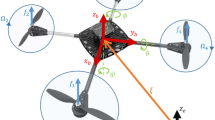Abstract
In this paper, a self-tuning proportional double derivative-like neural network nonlinear adaptive controller for attitude tracking control of an unmanned aerial vehicle (UAV) is presented. The proposed scheme consists of neural networks with two neural nodes in the hidden layer and includes activation feedback. The error between the desired angle set-point and the output as well as the change of error is selected as the controller input. The optimal initial weight parameters are obtained by employing an adaptive ant colony optimization. The proposed controller can online tune the weight parameters of the hidden layer with a stable learning rate based on the controller input. The effect of the learning rates on the stability of the neural network controller was analyzed. The designed controller was developed based on a nonlinear model of an UAV with quaternion representation in the presence of parametric uncertainties and external disturbances. Simulation results demonstrate the validity and effectiveness of the proposed algorithm with different reference attitude signals.










Similar content being viewed by others
References
Bouabdallah S, Noth A, Siegwart R (2014) PID vs LQ control techniques applied to an indoor micro quadrotor. In: IEEE/RSJ international conference on intelligent robots and systems (IROS 2004)
Tayebi A, McGilvray S (2006) Attitude stabilization of a VTOL quadrotor aircraft. IEEE Trans Control Syst Technol 14(3):562–571
DongBin L, Burg TC, Bin X, Dawson DM (2007) Output feedback tracking control of an underactuated quad-rotor UAV. In: American control conference
Jo SJ, Chang SA, Choi K (2013) Analysis on dynamic characteristics and LQR control of a quadrotor aircraft with cyclic pitch. J Korean Soc Aeronaut Space Sci 41(3):217–225
Lee SK, Kim Y (2014) System modeling and waypoint guidance law designing for 6-DOF quadrotor unmanned aerial vehicle. J Korean Soc Aeronaut Space Sci 42(4):305–316
Yoo M-GH, Hong SK (2012) Target tracking control of a quadrotor UAV using vision sensor. J Korean Soc Aeronaut Space Sci 40(2):118–128
Raharja GBK, Kim GB, Yoon KJ (2010) Design of an autonomous hover control system for a small quadrotor. Int J Aeronaut Space Sci 11(4):338–344
Zuo Z (2010) Trajectory tracking control design with command-filtered compensation for a quadrotor. IET Control Theory Appl 4(11):2343–2355
Lin D, Ji Y, Wang W, Lin S (2017) Finite-time convergent guidance law based on second-order sliding mode control theory. J Aeronaut Space Sci 18(4):697–708
Lee H, Lee D, Lee J, Shim DH (2017) Design, implementation, and flight tests of a feedback linearization controller for multirotor UAVs. Int J Aeronaut Space Sci 18(4):740–756
Jurdjevic V (1996) Geometric control theory. Cambridge University Press, Cambridge
Taeyoung L (2011) Geometric tracking control of the attitude dynamics of a rigid body on SO(3). In: American control conference (ACC)
Tayebi A (2008) Unit quaternion-based output feedback for the attitude tracking problem. IEEE Trans Autom Control 53(6):1516–1520
Mayhew CG, Sanfelice RG, Teel AR (2013) On path-lifting mechanisms and unwinding in quaternion-based attitude control. IEEE Trans Autom Control 58(5):1179–1191
Hao L, Xiafu W, Yisheng Z (2015) Quaternion-based robust attitude control for uncertain robotic quadrotors. IEEE Trans on Ind Inform 11(2):406–415
Morari M, Zafiriou E (1989) Robust process control. Prentice Hall, Englewood Cliffs, NJ
Ho WK, Hang CC, Cao LS (1995) Tuning of PID controllers based on gain and phase margin specifications. Automatica 31(3):497–502
Tzafestas S, Papanikolopoulos NP (1990) Incremental fuzzy expert PID control. IEEE Trans Ind Electron 37(5):365–371
Kang J, Meng W, Abraham A, Liu H (2014) An adaptive PID neural network for complex nonlinear system control. Neurocomputing 135:79–85
Ota T, Omatu S (1996), Tuning of the PID control gains by GA. In: IEEE conference on emerging technologies and factory automation
Zeng G-Q, Chen J, Chen M-R, Dai Y-X, Li L-M, Lu K-D, Zheng C-W (2015) Design of multivariable PID controllers using real-coded population-based extremal optimization. Neurocomputing 151:1343–1353
Sahib MA (2015) A novel optimal PID plus second order derivative controller for AVR system. Eng Sci Technol Int J 18(2):194–206
Raju M, Saikia LC, Sinha N (2016) Automatic generation control of a multi-area system using ant lion optimizer algorithm based PID plus second order derivative controller. Int J Electr Power Energy Syst 80:52–63
Dierks T, Jagannathan S (2010) Output feedback control of a quadrotor UAV using neural networks. IEEE Trans Neural Netw 21(1):50–66
Lee T, Kim Y (2001) Nonlinear adaptive flight control using backstepping and neural networks controller. J Guid Control Dyn 24(4):675–682
Nguyen AT et al (2017) Application of artificial neural networks to predict dynamic responses of wing structures due to atmospheric turbulence. Int J Aeronaut Space Sci 18(3):474–484
Chen X et al (2017) H infinity control design for eight-rotor MAV attitude system based on identification by interval type II fuzzy neural network. Int J Aeronaut Space Sci 17(2):195–203
Isidori A, Marconi L, Serrani A (2003) Robust nonlinear motion control of a helicopter. IEEE Trans Autom Control 48(3):413–426
Acknowledgements
This work was supported by the 2017 Research Fund of the University of Ulsan.
Author information
Authors and Affiliations
Corresponding author
Rights and permissions
About this article
Cite this article
Tran, TT., Ha, C. Self-Tuning Proportional Double Derivative-Like Neural Network Controller for a Quadrotor. Int. J. Aeronaut. Space Sci. 19, 976–985 (2018). https://doi.org/10.1007/s42405-018-0091-6
Received:
Revised:
Accepted:
Published:
Issue Date:
DOI: https://doi.org/10.1007/s42405-018-0091-6




